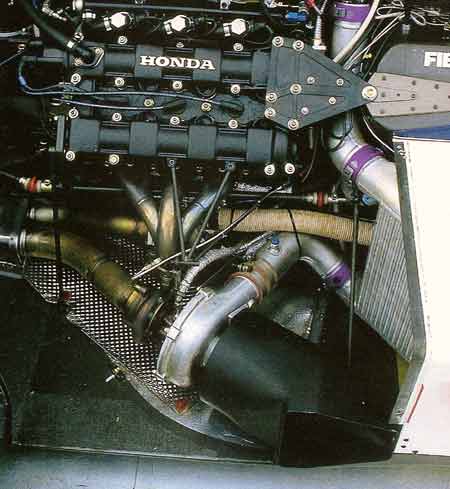The intercooler
Practitioners of engineering design will be familiar with the concept of compromise and the trade-off of one engineering parameter against another. A good best example of this - the 'art' of design as it were - must be the task of cooling the intake charge on a turbocharged engine. Generally referred to as an intercooler, or if you are a turbocharger designer an aftercooler, the idea is to reduce the charge air temperature to as close to the compressor intake temperature as possible while at the same time minimising the pressure loss to the engine.
By their very nature, centrifugal compressors - indeed all air compressors - are inefficient to some extent, and this inefficiency is expressed as an increase in the air temperature during compression. Unfortunately, however, increasing the charge temperature has the double whammy of not only reducing the charge density and therefore the amount of air going into the cylinder (and hence power) but also, by increasing the charge temperature, once inside the combustion chamber it is that much closer to 'knock' or the uncontrollable detonation in a turbocharged engine. For any competition engine therefore, the design of the intercooler is critical.
Efficient charge cooling is a matter of creating a large, efficient thermal transfer surface and the necessary airflow geometry to create efficient heat transfer. In the case of an air-to-air cooler, this means the engine air flowing through it and into the engine as well as that flowing through and around the heat exchanger matrix, dissipating the heat to the surrounding air.
At first one could be forgiven for thinking that the larger the matrix, the more effective the heat transfer, since a large surface area and minimum pressure drop through the engine intake side will be most beneficial to engine performance. However, large intercooler volumes create transient engine response issues as well as weight and high aerodynamic drag once installed in the vehicle. Furthermore, unless it is carefully marshalled, the tendency will be for the air to flow through one particular part of the matrix, meaning that the matrix will not be as efficient as expected and will fail to generate the heat transfers desired. Unlike most naturally aspirated power units, turbocharged and intercooled engines are very much more an integral part of the vehicle, and what may be best for engine power may not always be beneficial to the aerodynamics/weight of the vehicle once the intercooler is fully installed in the chassis.
Inside the intercooler the airflow has to be carefully managed to ensure that the flow passing through or around the many metal tubes and fins is as turbulent as possible without generating too much of a pressure drop. Laminar flow - when the lower layers of air remain adjacent to the heat transfer surface - is the killer of efficient heat transfer, since in this instance the air here is close to being totally static and acts more as insulation rather than an efficient heat transport medium. Let's not forget that the air gap in double-glazed windows is designed to insulate against, not promote, heat transfer, so unless the flow is fully turbulent where it matters, the effect inside the cooler could well be that of insulation.
High heat transfer through large flow areas (and hence low intake pressure losses) may be good for the engine, and small, lightweight intercoolers with minimum cross-section (and hence aerodynamic drag) may be good for the chassis. As a designer balancing all this and producing the best possible transient performance for the engine when installed in the chassis will no doubt keep you awake at night.

Fig. 1 - Intercooler installation
Written by John Coxon